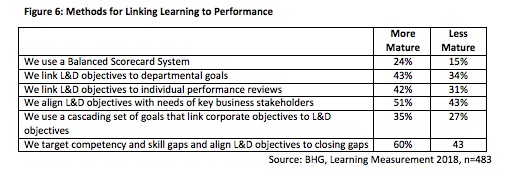
Organizations continue to struggle with developing a solid learning and development strategy that makes a genuine impact on the business. This challenge leaves many companies without the guidance necessary to design, develop, and deliver effective learning programs to boost not only individual performance, but organizational performance, as well. According to Brandon Hall Group’s 2018 Learning Strategy Survey, 17 percent of companies overall say they have no L&D strategy whatsoever.
However, even among companies with a strategy in place, the majority don’t believe their strategy is effective in helping achieve business goals.

Only 6 percent of companies say their L&D strategy is very effective in helping achieve business goals. That’s less than the amount saying their strategy is completely ineffective. This becomes less surprising when we see that only 39 percent of companies report their learning strategy is linked to the business.
Tackling Alignment
This relative lack of alignment does not mean organizations fail to see the value in having learning aligned with the business. In fact, 78 percent of companies say it is either important or critical that the learning strategy is connected to business goals.

Why is there such a huge disconnect? If most companies know it is important to their success, why are so few able to achieve it? To start, most companies just aren’t ready to tackle the alignment.

This highlights the heart of the problem. Companies know they must align learning with business goals and understand they are not very good at it, but they simply do not know where or how to start. It can be exceptionally challenging to retroactively align a strategy. It makes far more sense to create alignment when the strategy is developed. But for many companies, business tends to move faster than learning. Whatever alignment may have existed can easily become obsolete as business goals change.
The challenge is to move forward and not fall victim to a couple of common pitfalls:
- Doing nothing new because “this is how it has always been done.”
- Doing nothing for fear that the business will keep changing and the learning strategy will never keep up.
The research shows that in those companies with stronger alignment, learning has a much bigger impact on outcomes. Without the alignment, learning starts to exist in a vacuum, impacting nothing but the learning itself.
Getting Started
We can use the results of the survey to glean insights into best practices for aligning learning to the business. We start by breaking the respondent companies into two groups. Group A says their learning strategy is either effective or very effective in helping achieve business goals, and Group B says their strategy is either somewhat or not at all effective. Right away, we can see there is a significant difference in how important identifying critical skills and competencies can be.

While almost all of Group A says identifying these skills and competencies is important, just more than three-quarters of Group B say the same. The story is much the same for defining the capabilities and content required for these skills. The differences become even starker when we look at how effective the two groups are at accomplishing these things.

Group A outshines Group B by a huge margin. By being better at identifying the skills and competencies required for business success and providing learning that improves the capabilities required to master them, the companies in Group A can say their learning is doing a far better job of moving the needle on business objectives.
Rather than looking at the learning strategy as some giant contract etched in granite that would take heroic efforts to revise, it makes more sense to take a smaller, more precise look at things that can be changed. Bottom-up planning makes it easier to create a learning strategy based on desired performance outcomes.
Brandon Hall Group’s 2018 Learning Measurement Survey also uncovers strategies for creating alignment. When we look at companies with mature learning measurement strategies—ones where companies are actually measuring learning’s impact on the business—we see they are more likely to employ a variety of methods than companies with less mature measurement strategies.

While some methods are clearly more popular than others, in every case, companies with mature measurement strategies are using them all more.
Measurement
Measurement plays a key role in the alignment of learning and business goals, yet less than two-thirds (62 percent) of companies say that trying to create a stronger link to organizational performance is a primary driver for measuring learning.
If companies are not properly measuring learning, they will never know if their learning is having an impact and, therefore, can’t actually check their alignment. It’s one thing to declare your learning strategy is in line with the business when it is developed, but if the results do not bear that out, it’s back to square one.
Key Takeaways
- Get started. If there is no current alignment, redevelop your learning strategy.
- Be agile. Do not set the strategy in stone. It must be fluid and dynamic to keep up with the needs of the business.
- Identify and include key business stakeholders. Do not assume L&D understands all the objectives of the business.
- Understand the individual skills and competencies necessary for the business to succeed. Target learning there, and it will naturally help the business.
- Measure learning’s effectiveness by looking at business-related outcomes. If the strategy is strong, those outcomes already will be linked. Measurement will confirm if it is working.
David Wentworth is principal learning analyst at Brandon Hall Group, an independent research/analyst firm in the human capital management market. The firm’s vision is to inspire a better workplace experience, and its mission is to empower excellence in organizations around the world through its research and tools. Brandon Hall Group has five HCM practices, and produces the Brandon Hall Group Excellence Awards; the Women in Leadership Summit, June 6-7 in Fort Lauderdale, FL; and the annual HCM Excellence Conference, Jan. 22-25, 2019, in West Palm Beach, FL.



